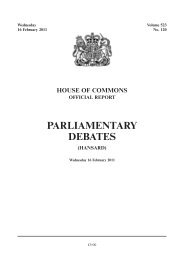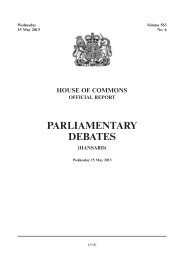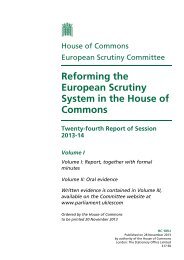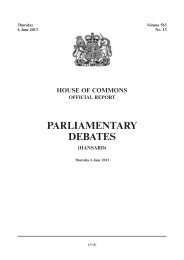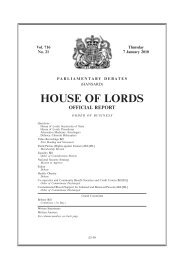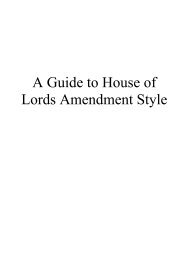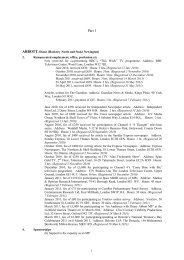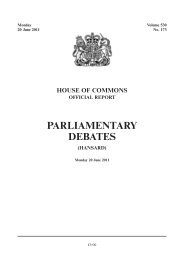Ticketing and Concessionary Travel on Public Transport - United ...
Ticketing and Concessionary Travel on Public Transport - United ...
Ticketing and Concessionary Travel on Public Transport - United ...
You also want an ePaper? Increase the reach of your titles
YUMPU automatically turns print PDFs into web optimized ePapers that Google loves.
<strong>Transport</strong> Committee: Evidence Ev 95<br />
that have been made for the extra revenue earned from measures such as ticket barriers are not based <strong>on</strong><br />
any objective assessment of the before <str<strong>on</strong>g>and</str<strong>on</strong>g> after eVects over a l<strong>on</strong>ger time period. Short term revenue<br />
changes certainly occur but can lead to overstatement of the l<strong>on</strong>g term impact.<br />
5. In my business we have developed a statistically sound methodology to support surveys <strong>on</strong> fare<br />
evasi<strong>on</strong>. While this has been applied in a few cases, in general we have found a lack of interest in the proper<br />
measurement of this important topic. Managers have tended to rely in simplistic soluti<strong>on</strong>s to undefined<br />
problems, <str<strong>on</strong>g>and</str<strong>on</strong>g> have actually spent large amounts of m<strong>on</strong>ey, usually <strong>on</strong> ticket barriers, in the belief that they<br />
are a proven generator of additi<strong>on</strong>al revenue, while not evaluating alternative opti<strong>on</strong>s, such as the more<br />
intelligent deployment of staV. The stati<strong>on</strong> gating agenda has advanced to the point where it appears to be<br />
accepted policy by the DfT, most TOC owning groups <str<strong>on</strong>g>and</str<strong>on</strong>g> c<strong>on</strong>sumer bodies. Franchise tenders call for them<br />
<str<strong>on</strong>g>and</str<strong>on</strong>g> bid commitments claim such schemes to be a benefit for passengers.<br />
6. It is my c<strong>on</strong>tenti<strong>on</strong> that this should be challenged <strong>on</strong> a number of grounds: that it is not necessarily<br />
cost eVective, is often customer unfriendly <str<strong>on</strong>g>and</str<strong>on</strong>g> that many of the benefits claimed for such equipment are<br />
overstated or misapplied.<br />
7. That is not state that gates are inappropriate in all circumstances. The barrier types used in Britain<br />
were developed for use <strong>on</strong> urban networks with high volumes of passengers, mostly unencumbered <str<strong>on</strong>g>and</str<strong>on</strong>g><br />
familiar with the system, such as L<strong>on</strong>d<strong>on</strong> Underground where alternative <str<strong>on</strong>g>and</str<strong>on</strong>g> adequate methods of c<strong>on</strong>trol<br />
are diYcult to envisage. Those used by Eurostar are entirely diVerent, both in their purpose <str<strong>on</strong>g>and</str<strong>on</strong>g> method of<br />
operati<strong>on</strong>, <str<strong>on</strong>g>and</str<strong>on</strong>g> would not be suitable for revenue c<strong>on</strong>trol of high volumes of traYc. They are <strong>on</strong>ly used for<br />
entry checks <str<strong>on</strong>g>and</str<strong>on</strong>g> are linked to the seat reservati<strong>on</strong> system.<br />
8. It is reas<strong>on</strong>able to accept that there are parts of the Nati<strong>on</strong>al Rail network where circumstances akin to<br />
LUL exist, with such heavy flows of regular users, that gates are an appropriate form of revenue protecti<strong>on</strong>.<br />
However there are important c<strong>on</strong>trasts between LUL <str<strong>on</strong>g>and</str<strong>on</strong>g> the NR system in general. LUL achieves a very<br />
high degree of gate compatible tickets (over 99%) such that manual interventi<strong>on</strong> is limited, <str<strong>on</strong>g>and</str<strong>on</strong>g> the high<br />
penetrati<strong>on</strong> of Oyster cards in L<strong>on</strong>d<strong>on</strong> has made the gates easier <str<strong>on</strong>g>and</str<strong>on</strong>g> faster to use. In Central L<strong>on</strong>d<strong>on</strong> the<br />
minimum fare is that most comm<strong>on</strong>ly due which improves eVectiveness.<br />
9. At the major stati<strong>on</strong>s now gated by TOCs very diVerent circumstances apply. There is high degree of<br />
manual interventi<strong>on</strong> due to the many ticket types that are incompatible with barriers, or not correctly<br />
interpreted by them. Without further checks <strong>on</strong>ly the minimum fare at that stati<strong>on</strong> is protected. Also they<br />
cannot manage train specific checks, or validate discount entitlement or class of travel. Unlike LUL there<br />
is also no proper re-use or pass-back protecti<strong>on</strong>, <str<strong>on</strong>g>and</str<strong>on</strong>g> there is no visual cancellati<strong>on</strong> of tickets. It is therefore<br />
quite unrealistic to assume that such equipment will eliminate fare evasi<strong>on</strong>. At best it will help to enforce<br />
pre-travel ticket purchase (assuming such facilities are adequate), <str<strong>on</strong>g>and</str<strong>on</strong>g> support the mopping up of arriving<br />
revenue, usually from local services where <strong>on</strong> train or stati<strong>on</strong> based ticket selling is inadequate. Many more<br />
users are unfamiliar with gates <str<strong>on</strong>g>and</str<strong>on</strong>g> are encumbered with luggage so the staV providing assistance can be<br />
under c<strong>on</strong>tinuous pressure. This results in degraded st<str<strong>on</strong>g>and</str<strong>on</strong>g>ards of customer service <str<strong>on</strong>g>and</str<strong>on</strong>g> reduced revenue<br />
c<strong>on</strong>trol.<br />
10. Such informati<strong>on</strong> as I have been able to gather suggests that ticket gates at suburban stati<strong>on</strong>s are<br />
eVective to the extent of halving the fare evasi<strong>on</strong> rate. There are still the problems of inc<strong>on</strong>sistent manning<br />
(identified in the Passenger Focus evidence), manual interventi<strong>on</strong> <str<strong>on</strong>g>and</str<strong>on</strong>g> short tickets or multiple passage.<br />
There is also some evidence that this eVectiveness declines with length of journey where the other factors in<br />
fare evasi<strong>on</strong> come into play that the gates do not address. It is reas<strong>on</strong>able to assert therefore that for l<strong>on</strong>ger<br />
journeys (say of an hour or more) they are largely pointless in revenue protecti<strong>on</strong> terms as <strong>on</strong>-train checks<br />
are still needed <str<strong>on</strong>g>and</str<strong>on</strong>g> will be more eVective.<br />
11. Although, in my own evidence, I agreed that most passengers want to see acti<strong>on</strong> <strong>on</strong> fare evasi<strong>on</strong> <str<strong>on</strong>g>and</str<strong>on</strong>g> to<br />
feel their own h<strong>on</strong>esty in purchasing tickets recognised, I do not believe that ticket barriers enjoy widespread<br />
acceptance for this reas<strong>on</strong>. Access to <str<strong>on</strong>g>and</str<strong>on</strong>g> from trains is restricted, often with the closure of sec<strong>on</strong>dary<br />
entrances <str<strong>on</strong>g>and</str<strong>on</strong>g> exits, which extends times, c<strong>on</strong>gesti<strong>on</strong> is caused <str<strong>on</strong>g>and</str<strong>on</strong>g> many customers find them intimidating<br />
<str<strong>on</strong>g>and</str<strong>on</strong>g> diYcult to use. Meeters <str<strong>on</strong>g>and</str<strong>on</strong>g> greeters <str<strong>on</strong>g>and</str<strong>on</strong>g> those who may wish to use stati<strong>on</strong> facilities are deterred from<br />
legitimate use. The overall message is negative <str<strong>on</strong>g>and</str<strong>on</strong>g> unwelcoming, <str<strong>on</strong>g>and</str<strong>on</strong>g> <strong>on</strong>e has <strong>on</strong>ly to observe the operati<strong>on</strong><br />
of barriers at any major stati<strong>on</strong> where there are many irregular <str<strong>on</strong>g>and</str<strong>on</strong>g> encumbered users to come to this<br />
c<strong>on</strong>clusi<strong>on</strong>.<br />
12. Another stated benefit is security. Again this may well be true of the suburban stati<strong>on</strong> aZicted with<br />
idle youth <str<strong>on</strong>g>and</str<strong>on</strong>g> v<str<strong>on</strong>g>and</str<strong>on</strong>g>alism, but that may be as much due to visible staV as the actual equipment. Plainly it<br />
cannot be true of stati<strong>on</strong>s in general since the majority that have acquired secure stati<strong>on</strong> status do not have<br />
ticket gates. Also closing oV the platforms at major stati<strong>on</strong>s does nothing for security in the other public<br />
areas of the stati<strong>on</strong> where much of the crime risk still exists. Restricting access to facilities within a paid area<br />
to ticket holders makes them less frequented, which may not actually enhance security, <str<strong>on</strong>g>and</str<strong>on</strong>g> aVects the<br />
viability <str<strong>on</strong>g>and</str<strong>on</strong>g> attracti<strong>on</strong> of trading outlets.<br />
13. Any noti<strong>on</strong> that ticket barriers c<strong>on</strong>tribute to wider security c<strong>on</strong>cerns, such as the threats of terrorism,<br />
can be dispelled when it is recalled that the 7/7 bombers entered the system at Lut<strong>on</strong>, with tickets at a<br />
gated stati<strong>on</strong>.



